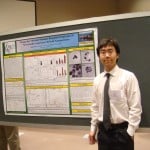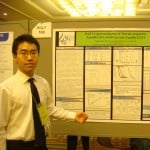Xin Yan
Original Research Proposal
Michigan Technological University
Department of Chemistry
Advisor-Dr. Lanrong Bi
Thursday, February 26, 2015
9:00 am Admin Building Room 404
Abstract
The Taiwaniadducts I and J, as cycloadducts of terpene quinones from taiwania cryptomerioides, will be synthesized. These two compounds are isolated from Taiwania cryptomerioides hayata, a large coniferous evergreen species common to Taiwan. They have potential in medical applications due to the breadth of their biological activities. However, low yields of these naturally extracted compounds limits further research on their biological activities and no synthetic approaches to these two compounds have been reported before. Herein, we design a synthetic route which can provide adequate quantities of target compounds for further biological studies. Moreover, the design methodology involved in this proposal may show a reasonable approach to the synthesis of this kind of cycloadducts.
Upper Peninsula ACS Local Section Research Seminar
“Carbon Nanomaterials: from Zero-dimensional Cages to Three-dimensional Graphene Sheets “
Dr. Yun Hang Hu, Charles and Carroll McArthur Endowed Chair Professor
Department of Materials Science and Engineering, Michigan Technological University
February 27, 2015 – 3:00 PM – Rekhi Hall G006
Abstract
Because of the bonding flexibility of carbon, carbon-based materials exhibit various structures with a large variety of physical and chemical properties. Three-dimensional carbon allotropes (graphite and diamond) have been known from the earliest history. The zero-dimensional carbon fullerenes and one-dimensional carbon nanotubes were discovered within the last 30 years. Furthermore, isolated two-dimensional graphene, which is a one-atom thick carbon layer with hexagonal ‘‘honeycomb” lattice, was experimentally obtained 10 years ago. Actually, the discovery of those nano-structured carbon materials is one of the most important developments in science and engineering. In this talk, Dr. Hu is going to discuss his research for (a) the defect structures and the endohedral complexes of C60, (b) the stability and structure of atomic carbon chains, and (c) the synthesis and application of three dimensional graphene sheets and their application for energy.
Biography
Dr. Yun Hang Hu is the inaugural Charles and Carroll McArthur Endowed Chair Professor at
Michigan Technological University. His main research interests range from nanomaterials, CO2 conversion, clean fuels, hydrogen storage materials, catalysis, quantum chemistry calculations to solar energy. He has published more than 120 peer reviewed papers in reputed journals (such as JACS, Angew. Chem. Int. Ed., and Adv. Mater.) and organized more than 20 international symposia on materials and energy. He was a program chair for the ACS Energy and Fuels Division. He is an editor for three books, an editorial board member for nine journals, a chair of the ACS Energy and Fuels Division, and a president of the Hydrogen Storage Division of the International Association of Hydrogen Energy (IAHE). He is a fellow of American Association for the Advancement of Science (AAAS) and the Royal Society of Chemistry (RSC).
Sarah Hopson (Advisor- Dr. Martin Thompson)
Doctoral Student, Department of Chemistry,Michigan Technological University
Monday, March 2, 2015-9:00 am- Admin 404
Abstract
Post-translational modifications of histones, such as the acetylation of lysines, play an importantrole in regulating transcription. Histone tails have a large proportion of positively-charged residues, which create electrostatic interactions with the negatively-charged DNA backbone. Lysine acetylation is thought to weaken these interactions, because it neutralizes lysine’s positively-charged side chain.
Proteins recognize the acetylated lysines using bromodomains; bromodomains are acetylated lysine “readers” and play a critical role in modulation of gene expression. Of the 46 bromodomain-containing proteins in the human proteome, 15 function as transcriptional regulators and 8 function as chromatin remodelers. Nearly all of the other bromodomain proteins influence transcription in some manner (histone acetyltransferase, transcription repressor, transcription initiation, etc.). Due to their significant influence on transcription, mutations of bromodomains are often linked with cancers.
Bromodomain-containing protein 9 (BRD9) has not yet been studied. The aim of this proposed research is to determine the specificity and affinity of BRD9 toward acetyl-lysine sites on the tails of the four core histone proteins.
A high-throughput examination of possible histone interactions with the bromodomain of BRD9 will be conducted using a modified SPOT array. The peptides demonstrating the strongest interactions with the bromodomain will be synthesized using standard Fmoc peptide synthesis. A quantitative examination of the binding affinities of these peptides to the bromodomain, the bromodomain and DUF3512 (domain of unknown function), and the full length BRD9 will be conducted using isothermal titration calorimetry. The results will be compared to determine how the surrounding amino acid sequences affect the bromodomain’s binding capabilities.
The Upper Peninsula Section of the American Chemical Society is now soliciting abstract submissions for the Student Research Symposium, which will be held at NMU’s New Science Facility in Marquette on Saturday, April 11, 2015.
The purpose of the event is to provide a venue for students to present their research in chemistry, chemical engineering and related fields. This symposium will be an excellent opportunity for students, faculty and the community at large to learn about the interesting research being conducted in the UP. This year the initiative will see the participation of presenters from schools within the Northeast Wisconsin local section.
Poster abstracts can be submitted online. The deadline for abstract submission is March 15. There is no registration fee.
Cash awards to the best posters will be given, and every participant will receive a gift from the UP local section.
Questions should be directed to Loredana Valenzano (lvalenza@mtu.edu), UPLS 2015 Chair.
PI Xiaohu Xia (Chem), “Facile Removal of Surface Ligands from Supported Platinum-Group Metallic Nanocrystals,” American Chemical Society
PI Loredana Valenzano (Chem), “Bringing New Efficiencies in Petroleum Refining Processes: A Quantum Chemical Investigation of Novel Porous Materials and Metal Oxide Surfaces for Olefin and Paraffin Separation,” American Chemical Society
PI Lanrong Bi (Chem/BRC), “Buckyballs-Based Mitochondrial Drug Delivery System for the Prevention and Treatment of Ischemia/Reperfusion Injury,” US Department of Health and Human Services, NIH
PI Marina Tanasova (Chem), “Discovering Probes to Overcome Cancer Resistence to DNA Alkylating Chemotherapy by High Throughput Evaluation of Polymerase Inhibition,” US Department of Health and Human Services, NIH
PI Lanrong Bi (Chem/BRC) and Co-PI Qinghui Chen (KIP/BRC), “Target Mitochondrial Fusion Process: Engineering of a Nanoparticals-Based Mitochondrial Drug Delivery Platform,” US Department of Health and Human Services-NIH
PI Martin Thompson (Chem), “Development of a Biological Platform to Study Histone Modifications,” NSF
PI Lynn Mazzoleni and Co-PI Marina Tanasova (Chem), “Collaborative Research: The Role of Inorganic Salts in Functionalization and Fragmentation of Isoprene Oxidation Product—A Molecular-Level Investigation,” NSF
PI Tarun Dam (Chem), “Role of Glycoconjugate Scaffolds in Lectin Recognition,” NSF
PI Haiying Liu and Co-PI Ashutosh Tiwari (Chem), ” BODIPY-Based Ratiometric Near-Infared Fluorescent Probes for Zinc(II) and Active Oxygen Species,” NSF
Haiying Liu (Chem), “Point-of-Care Rapid Detection by Label Free Cell and Nucleic Acid Assays,” Oakland Univeristy
Lynn Mazzoleni (Chem), “Collaborative Research: Nitrogen Partitioning and Evolution of Particulate Organic Nitrogen in Peat Fire Emissions,” National Science Foundation
Rudy Luck (Chem), “SusChEM: Using Abundant First Row Transition Metals to Accomplish Cross-Coupling for the Synthesis of Specific Drugs,” National Science Foundation
Dr. Pat Heiden’s student, Ning Chen, presented at the 42nd Central ACS Regional Meeting in Indianapolis IN in June 2011 as well as at the 243rd American Chemical Society (ACS) National Meeting in Anaheim CA in March 2011. Here are some photos of Ning with his poster:
ACS meetings are an excellent opportunity for students! Reach 12,000 chemical professionals at each 2012 national meeting or at other events throughout the year, including regional meetings.
Dr. Lynn Mazzoleni, an assistant professor of chemistry, is currently at the top of Mt. Pico, an extinct volcano in the Azores. She’s working on understanding aerosols’ chemistry and how they interact with sunlight.
Dr. Mazzoleni checked with us recently and shared a photo she took from the ferry as she arrived on day one. On that particular day the mountain was mostly free of clouds:
Learn more about the project by reading “Michigan Tech Researchers to Study Atmospheric Aerosols at PICO Mountain Research Observatory.”
Learn more about Dr. Mazzoleni and her research.


